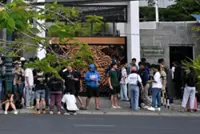Ramping up deployment of wind, solar and battery storage could help the region cut its reliance on coal and gas for power generation. - PHOTO: ST FILE
JAKARTA/SINGAPORE (The Straits Times): South-East Asia could unlock US$300 billion (S$407 billion - RM1.43 trillion) in additional annual revenues from green investments by 2030 if governments step up cooperation on regional grids and carbon markets and offer better incentives for clean energy and clearer rules on green financing, says a report released on April 15.
The rapidly growing region of nearly 700 million people remains heavily dependent on fossil fuels for energy. However, it faces a narrow window of opportunity to step up green investment to rein in the rapid growth of greenhouse gas emissions that are driving climate change, says the report by Bain & Company, GenZero, Standard Chartered and Temasek.
Titled South-east Asia’s Green Economy 2024 – Moving The Needle, the report outlines a range of opportunities for the region to cut greenhouse gas emissions and meet national climate targets, while also improving energy and food security. What is missing is US$1.5 trillion in finance, policy incentives and regional cooperation to make this happen, according to the authors.
A key theme of the report is that many of the green investments can be deployed now and rapidly scaled up to make a real difference in cutting planet-warming emissions that are also causing air pollution across the region.
“In South-east Asia, we’re seeing opportunities that are extremely actionable in the near term,” said Ms Kimberly Tan, head of investments at GenZero, an investment platform founded by Temasek that is focused on accelerating decarbonisation. “We believe that investments into the green economy could generate as much US$300 billion in annual revenues by 2030.”
Nature and agriculture, transport and power generation represent US$220 billion of the total revenues. For example, investments in sustainable rice cultivation could cut water use and emissions of methane, a powerful greenhouse gas. Nature-based solutions such as protecting rainforests and replanting mangroves could suck planet-warming carbon dioxide (CO2) out of the air while benefiting local communities – mangroves are excellent fish nurseries and protect coastlines from storms.
Ramping up deployment of wind, solar and battery storage could help the region cut its reliance on coal and gas for power generation, while mandates on energy efficiency in buildings could also reduce electricity demand growth.
These are among 13 investable ideas across four sectorial themes: nature and agriculture, power generation, transport and buildings highlighted by the report, which was released on the sidelines of Ecosperity Week 2024 at the Sands Expo and Convention Centre.
But the financing gap remains vast. The report says green investments in the region rose 20 per cent year on year in 2023 to US$6.3 billion. But this is a fraction of the US$1.5 trillion needed to accelerate South-east Asia’s green transition and to meet its 2030 climate pledges under the United Nations Paris climate agreement.
Mr Dale Hardcastle, director of the global sustainability innovation centre at Bain & Company, told a media briefing on April 11: “Immense potential exists to accelerate the energy transition and build the green economy. We need to start with what we can do here and now, and not miss the opportunity at hand.”
The region’s 10 economies are rapidly growing and will need major investments in energy, especially renewable energy for power generation, in the decades ahead.
For instance, the 7th Asean Energy Outlook, a 2022 report by the Asean Centre for Energy, estimates that electricity generation capacity will more than double between 2025 and 2050 based on the region’s current climate policies. Total energy-related greenhouse gas emissions will also double by 2050 to four billion tonnes of CO2 equivalent.
But with the jump in emissions come growing climate risks, notes the report, with Asean already one of the regions highly vulnerable to increasing heat, more intense storms and floods, and rising sea levels.
By 2030, the region needs to cut emissions by a total of 2.4 billion tonnes of CO2-equivalent if it is to meet national climate pledges, the report says.
Asked what is holding the region back, Mr Hardcastle offered three reasons.
“There’s the challenge of competing priorities for governments,” he said. “Leaders not only have to balance thinking about the post-Covid-19 world, but they also have to balance rapidly growing economies and the need to increase energy.” He pointed to millions of people still without access to the power grid.
The second challenge is incumbency, which is the region’s deep dependency on fossil fuels for energy. And in some Asean nations, coal, oil and gas are also major sources of export earnings.
Mr Hardcastle pointed to the region’s large and young fleet of coal-fired power stations. Closing these down early and replacing them with renewable energy is a very costly challenge, though efforts are under way to try to figure out how to do this.
“Thirdly, we’ve still not had sufficient incentives or access to capital to be able to move at the pace that we want,” he said. But he noted progress in new types of financing that help lower the cost and risk of green investments, such as blended finance. This combines public and private money, such as grants, concessional loans and commercial capital.
“The change and the transformation we’re seeking... is unprecedented,” he added.
Ms Tan pointed to the region’s low level of renewable energy deployment and nascent electric vehicle industry. Much of its agriculture also remains unsophisticated compared with the large-scale farms in the West, mainly because many smallholders do not have access to technology.
“Many of these decarbonisation investment ideas will take time, but you definitely need to act as soon as possible,” she said. - The Straits Times/ANN





